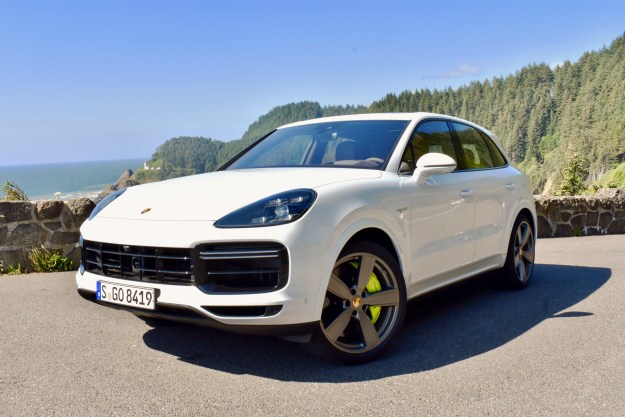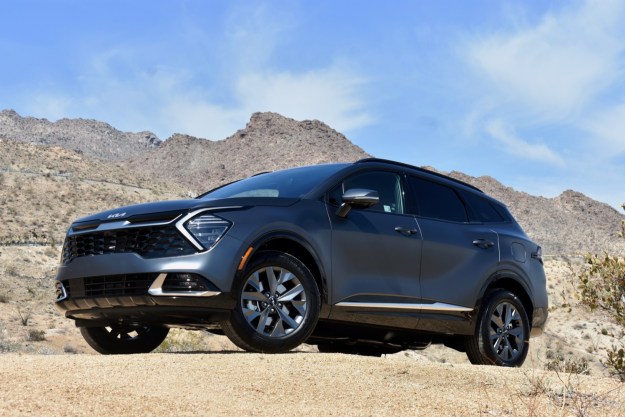
Porsche has taken the old saying “variety is the spice of life” to heart. The German automaker has a knack for developing seemingly endless variants of its handful of models, each adding some new flavor to the same basic ingredients. Case in point: the 2020 Porsche Cayenne Turbo S E-Hybrid.
The Turbo S E-Hybrid follows the 2019 Porsche Cayenne E-Hybrid. Both are plug-in hybrids, but the Turbo S swaps the base E-Hybrid’s turbocharged V6 for a twin-turbo V8. The combination of V8 and electric muscle makes the Turbo S E-Hybrid the most powerful Cayenne you can buy, or at least it will, when the SUV hits showrooms.
The Cayenne Turbo S E-Hybrid won’t launch in the United States until calendar year 2020, but Porsche secretly brought one over from Germany for us to drive alongside the base E-Hybrid. Since Porsche hadn’t even announced the Turbo S yet, we weren’t allowed to talk about it until now. With the car now out of the bag, we can tell you that the Turbo S will start at $163,150 – a major increase over the base E-Hybrid’s $81,150 base price (all prices include a mandatory destination charge). Is the Turbo S worth the extra coin? Let’s find out.
The devil is in the details
Only a true Porsche nerd will be able to pick the Turbo S E-Hybrid out of a lineup of current-generation Cayennes. That’s why Porsche let use drive the new model uncamouflaged up and down coastal Oregon roads a few weeks before its existence was made public. No one in that beachside locale knew what to look for.
The splashes of Acid Green paint on the badges and brake calipers tell you this Cayenne is a plug-in hybrid, while the more-aggressive front fascia, quad exhaust tips, and massive brake rotors tell you it’s a Turbo S, and not the base V6 model. Porsche will offer the Turbo S E-Hybrid in the Cayenne body style and as a coupe, but we didn’t get to drive the latter.
The interior is similar to other Cayenne variants, which isn’t a bad thing. Some styling elements, like the central tachometer, reference the Porsche 911, giving the Cayenne a distinct character from other luxury SUVs. The 12.3-inch touchscreen infotainment system is a high-quality item, but Porsche only offers Apple CarPlay (Android Auto may become available soon, though). The Turbo S E-Hybrid’s base price may be eye watering, but at least it means you get the best of the best. The fantastic 18-way adjustable power adjustable sport seats that are an optional extra on the base E-Hybrid are standard on the Turbo S, for example.
The V8 produces a soundtrack worthy of NASCAR.
We expect measurements from the base E-Hybrid to carry over to the Turbo S, meaning you get a bit less space than non-hybrid Cayenne variants – not to mention some key rival vehicles. The 14.1-kilowatt-hour battery pack sits under the floor of the cargo area, so that floor is slightly higher in the Turbo S E-Hybrid than in a non-hybrid Cayenne. Plug-in hybrid versions of the BMW X5 and Volvo XC90 will likely offer more cargo space, and the Volvo is also available with a third-row seat. But neither of these options can’t compete against the way this Porsche drives.
Thunder and lightning
The Cayenne Turbo S E-Hybrid isn’t the first plug-in hybrid performance vehicle – Porsche’s own 918 Spyder supercar helped set that template. But this SUV utilizes the one-two punch of internal combustion and electric power to maximum effect.
A 4.0-liter twin-turbocharged V8 and electric motor work together to produce 670 horsepower and 663 pound-feet of torque, which is sent to all four wheels through an eight-speed automatic transmission. To put that in perspective, the V6-engine Cayenne E-Hybrid produces 455 hp and 516 lb-ft. The Cayenne Turbo, which has the same V8 engine as the Turbo S minus the hybrid system, has 541 hp and 567 lb-ft. So the most powerful Cayenne you can buy is a plug-in hybrid. Welcome to the future.

Porsche claims the 2020 Turbo S E-Hybrid is also the fastest Cayenne ever. The plug-in hybrid can reach a top speed of 183 mph. That’s faster than a Range Rover Sport SVR, and within spitting distance of the 189-mph Lamborghini Urus and 190-mph Bentley Bentayga Speed – both of which share a basic platform with the Cayenne. That 7 mph difference between the Porsche and the Bentley (currently the world’s fastest production SUV) won’t be noticeable anywhere other than a racetrack or an autobahn.
The Cayenne Turbo S E-Hybrid is also slightly faster than the more proletarian Jeep Grand Cherokee SRT Trackhawk, which requires 707 hp to reach 180 mph. The Jeep is just slightly quicker from zero to 60 mph than the Porsche, at 3.5 seconds versus the Cayenne’s 3.6 seconds. The Cayenne is still quicker than a Ranger Rover Sport SVR and Bentayga Speed, and just about matches the Urus.
The balance of gasoline and electric power are managed seamlessly for the driver.
The way the Cayenne produces those numbers is pretty impressive, too. First impressions are all about that V8, which produces a soundtrack worthy of NASCAR. But that electric motor is always working in the background, providing an extra boost of power and filling in dips in the V8’s torque curve to keep acceleration at a ferocious level. With the sonorous V8 filling your ears and the silent force of electric power providing an added kick, it’s like being in a jet airliner getting pushed along by a tailwind.
Porsche also deploys plenty of tech to keep the driver out of ditches – an important consideration when said driver is wielding 670 horses in a tall, heavy SUV package. Standard features include adaptive air suspension, a torque-vectoring feature for the all-wheel drive system, and Porsche Dynamic Chassis Control, which uses a 48-volt electrical system to actively adjust the anti-roll bars (similar technology is used by Porsche sibling Bentley). These features are all optional extras on lesser Cayenne models. The Turbo S E-Hybrid also comes standard with carbon-ceramic brakes, while rear-wheel steering is available as an option.
These features add up to a chassis that’s more than a match for the Cayenne’s immense power, giving you the confidence to exploit that power. As with the base Cayenne E-Hybrid, the balance of gasoline and electric power, as well as the various driver aids, are managed seamlessly for the driver. All you have to do is put your foot down.
More mean than green
Makers of plug-in hybrids often highlight gas mileage, but with the Cayenne Turbo S E-Hybrid we think Porsche was more interested in increasing performance than decreasing fuel consumption. EPA fuel-economy and electric-range ratings are still pending, according to Porsche. Unfortunately, we didn’t get enough drive time in the Turbo S E-Hybrid to calculate a reliable fuel-economy figure.
As with all plug-in hybrids, getting maximum efficiency from the Turbo S E-Hybrid will require regular charging and driving in electric mode. Given the intoxicating sound and power of that V8, though, we’re not sure how many customers will actually do that.
The 2020 Porsche Cayenne S E-Hybrid is the thinking person’s performance SUV.
And while it does have electric assist, this is still a V8, so expect a strong thirst for gasoline. This Porsche is much more comfortable embarrassing other performance SUVs than doing a Prius impression.
For those that do plan to regular charge their Turbo S E-Hybrids, this model gets the more powerful 7.2-kilowatt onboard charger that’s an optional extra on the base E-Hybrid. However, Porsche does not offer a DC fast-charging option. As with the base E-Hybrid, the Turbo S and can also use its gasoline engine to charge the battery pack in the E-Charge and Sport Plus driving modes, but you will need to plug in eventually to get a full recharge.
The practical stuff
Despite its price, the 2020 Porsche Cayenne Turbo S E-Hybrid is somewhat lacking in standard driver aids. A pedestrian protection system that can automatically apply the brakes to avoid collisions is standard equipment, but adaptive cruise control and lane keep assist are optional extras. The adaptive cruise control system is at least fairly clever. It can bring the Cayenne to a complete stop in traffic and resume moving again, and can work with the navigation system to plot the ideal combination of acceleration and braking for the next 1.8 miles of road.

Porsche offers a four-year, 50,000-mile, warranty with a 12-year corrosion warranty, and also pays for servicing at dealerships. The Turbo S E-Hybrid is a new model, but other recent Cayenne variants received fairly low reliability scores from Consumer Reports. Porsche was also one of the lowest-ranked brands in the most recent J.D. Power Initial Quality Study. Crash test scores from the National Highway Traffic Safety Administration (NHTSA) and Insurance Institute for Highway Safety (IIHS) are not available at this time.
How DT would configure this car
Porsche did most of the work for us on this one. From its 18-way power-adjustable seats to its carbon-ceramic brakes, the Turbo S E-Hybrid gets many of the options we would have wanted on our ideal base Cayenne E-Hybrid as standard equipment. The only thing we would add is the optional adaptive cruise control system.
Summary
The 2020 Porsche Cayenne Turbo S E-Hybrid uses existing ingredients to make a tasty new recipe. The base, V6-engine Cayenne E-Hybrid was plenty quick, but the addition of the 4.0-liter twin-turbo V8 from the non-hybrid Cayenne Turbo takes things to another level. Porsche has built itself a performance SUV to rival fellow Volkswagen Group brands Bentley and Lamborghini, and sets a high bar for the next-generation BMW X5 M and Mercedes-AMG GLE.
Should you get one?
Yes. It may not offer the stripped-down appeal of the automaker’s sports cars, but the 2020 Porsche Cayenne S E-Hybrid is the thinking person’s performance SUV.
Editors' Recommendations
- Mercedes-AMG EQE SUV first drive review: a better electric SUV
- Mercedes-Benz EQE SUV first drive review: ’90s look, cutting-edge tech
- 2023 Kia Niro EV first drive review: Practical doesn’t have to bore you to tears
- 2022 Mercedes-Benz EQB first drive review: An EV better than its gas sibling
- 2022 Rivian R1S first drive review: An EV SUV fit for an expedition or a drag race










